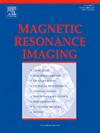通过并行采集技术(PAT)和局部主成分分析(LPCA)增强的同步多层(SMS)加速MR细胞大小成像。
IF 2
4区 医学
Q2 RADIOLOGY, NUCLEAR MEDICINE & MEDICAL IMAGING
引用次数: 0
摘要
显微结构参数在肿瘤研究中是必不可少的,有助于了解肿瘤的发病机制、分级和治疗效果。利用有限光谱编辑扩散(impulse)模型成像显微结构参数是应用最广泛的MR细胞大小成像技术,在体内测量实体肿瘤的显微结构参数方面取得了成功。然而,其临床应用受到脉冲梯度自旋回波(PGSE)和多个振荡梯度自旋回波(OGSE)在b值范围内采集所需的较长扫描时间的限制,这可能给患者带来负担并扰乱临床工作流程。在这项工作中,我们提出并评估了一种加速方法,该方法将并行采集技术(PAT)和同步多片(SMS)与局部主成分分析(LPCA)去噪相结合,以减少扫描时间,同时保持MR细胞尺寸成像的图像质量。采用P2S2 (PAT2-SMS2)、P2S3 (PAT2-SMS3)和P3S3 (PAT3-SMS3)配置获取PGSE和OGSE (25 Hz, 50 Hz)图像,结合LPCA去噪,并与健康志愿者和3 t脑肿瘤患者的标准P2 (PAT2-SMS1)进行比较,并通过定性和定量评价进一步评估临床可行性。由两名放射科医生使用5点李克特量表进行定性评估,并进行定量分析,包括噪声估计、表观扩散系数(ADC)计算和微结构参数估计-细胞直径(Dmean)、细胞内体积分数(Vin)和细胞外扩散率(Dex)。总的来说,与标准P2加速相比,PAT和SMS技术的集成将采集时间减少了大约60%,同时保持了与LPCA去噪相当的图像质量和结构保真度。本文章由计算机程序翻译,如有差异,请以英文原文为准。
Accelerated MR cell size imaging through parallel acquisition technique (PAT) and simultaneous multi-slice (SMS) with local principal component analysis (LPCA) enhancement
Microstructural parameters are essential in tumor research, aiding in the understanding tumor pathogenesis, grading, and therapeutic efficacy. The imaging microstructural parameters using limited spectrally edited diffusion (IMPULSED) model is the most widely used MR cell size imaging technique, demonstrating success in measuring microstructural parameters of solid tumors in vivo. However, its clinical application is limited by the longer scan times required for both pulsed gradient spin-echo (PGSE) and multiple oscillating gradient spin-echo (OGSE) acquisitions across a range of b-values, which can be burdensome for patients and disrupt clinical workflows. In this work, we propose and evaluate an accelerating method that integrates parallel acquisition technique (PAT) and simultaneous multi-slice (SMS) with local principal component analysis (LPCA) denoising to reduce scan times while maintaining image quality in MR cell size imaging. PGSE and OGSE (25 Hz, 50 Hz) images were acquired using P2S2 (PAT2-SMS2), P2S3 (PAT2-SMS3), and P3S3 (PAT3-SMS3) configurations, incorporating LPCA denoising, and compared to standard P2 (PAT2-SMS1) in healthy volunteers and brain tumor patients at 3 T. Additionally, clinical feasibility was further assessed through qualitative and quantitative evaluations. Qualitative assessment, conducted by two radiologists using a 5-point Likert scale, and quantitative analysis, including noise estimation, apparent diffusion coefficient (ADC) calculation, and estimation of microstructural parameters—cell diameter (Dmean), intracellular volume fraction (Vin), and extracellular diffusivity (Dex), were performed. Overall, the integration of PAT and SMS techniques reduces acquisition time by approximately 60 % compared to standard P2 acceleration, while maintaining comparable image quality and structural fidelity with LPCA denoising.
求助全文
通过发布文献求助,成功后即可免费获取论文全文。
去求助
来源期刊

Magnetic resonance imaging
医学-核医学
CiteScore
4.70
自引率
4.00%
发文量
194
审稿时长
83 days
期刊介绍:
Magnetic Resonance Imaging (MRI) is the first international multidisciplinary journal encompassing physical, life, and clinical science investigations as they relate to the development and use of magnetic resonance imaging. MRI is dedicated to both basic research, technological innovation and applications, providing a single forum for communication among radiologists, physicists, chemists, biochemists, biologists, engineers, internists, pathologists, physiologists, computer scientists, and mathematicians.
 求助内容:
求助内容: 应助结果提醒方式:
应助结果提醒方式:


